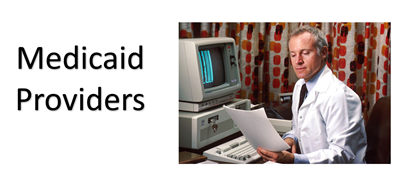MM Curator summary
Nebraska providers are recognized for their impact on Medicaid members.
The article below has been highlighted and summarized by our research team. It is provided here for member convenience as part of our Curator service.
Media Contacts:
Taylor Gage, Governor’s Office, 402-471-1970
Barb Tyler, Dept. of Health and Human Services, 402-471-3486
Media Release:
Gov. Ricketts Presents 2021 Medicaid Provider Awards
From left to right: (DHHS CEO Dannette R. Smith, DHHS Director of Medicaid and Long-Term Care
Kevin Bagley, Dr. Sami Webb, Gov. Ricketts, Dr. Paula Harre)
LINCOLN – Today, Governor Pete Ricketts; Dannette R. Smith, CEO of the Department of Health and Human Services (DHHS); and Kevin Bagley, Director of the DHHS Division of Medicaid and Long-Term Care, honored four doctors with Nebraska Medicaid Provider awards. The awards recognize outstanding providers within Heritage Health Adult, Nebraska’s Medicaid program.
“The winners of the Nebraska Medicaid Provider Awards delivered great customer service and responsibly stewarded taxpayer dollars,” said Gov. Ricketts. “They help deliver on DHHS’ mission to help Nebraskans lead better lives. Thank you to each of the award winners for your contributions to improving services for the people of Nebraska.”
Gov. Ricketts awarded one winner from each of the managed care organization (MCO) networks and dental plan. The MCOs are UnitedHealthcare Community Plan of Nebraska, Nebraska Total Care, Healthy Blue of Nebraska, and MCNA Dental. Award recipients were selected for having demonstrated exceptional care to the Medicaid population and measurable contributions during the pandemic through their clinical practice. Winners were nominated from within each of their respective organizations.
“We are extremely grateful to our Medicaid providers who help their fellow Nebraskans live better lives,” said Director Bagley. “During a difficult year, these providers went above and beyond in providing excellent service to our Medicaid members. These awards recognize their contributions to the Medicaid program and their commitment to improving the health of their community.”
The honorees of the Nebraska Medicaid Provider Awards are:
Dr. Kris McVea: Nominated with honor by Healthy Blue of Nebraska, Dr. McVea is passionate about the patients that both she and her team care for. Her suggestions and input have been invaluable, not only at OneWorld in Omaha where she serves as Medical Director, but also as an advocate for all Medicaid members in Nebraska. Dr. McVea has been an active member of her MCO quality improvement committee, and she also has led her team in pursuing quality metrics and goals for her clinics. Her dedicated approach combines her pediatrics and epidemiology/public health training. Dr. McVea uses data to drive quality health outcomes, but her dedication to the care of her patients is where she thrives. During the coronavirus pandemic, she helped push drive-through immunization clinics onsite at OneWorld. She also helped her team nimbly move to telemedicine visits on short notice to meet the needs of members.
Dr. McVea received her undergraduate degree from Stanford University and her medical degree with distinction from UNMC. She then earned her M.P.H. in Epidemiology from the University of North Carolina. Currently, she serves as a Graduate Faculty Member at the University of Nebraska Graduate College in Omaha. Last year, she was awarded both the Public Citizen of the Year from the National Association of Social Workers, Nebraska Chapter, and the Nebraska Medical Association’s Distinguished Service to Medicine honor.
Dr. John Tubbs: Nebraska Total Care (NTC) identified Dr. John Tubbs from Stuart, NE, as its nominee for the Governor’s Medicaid Award. Dr. Tubbs graduated from Ross University School of Medicine and completed his residency in Family Medicine at Creighton University School of Medicine. After he completed his residency in 2002, Dr. Tubbs went into practice at Midtown Family Practice in Omaha. In 2005, he and his wife, Erica, chose to move to Northeastern Nebraska to provide medical care to a more rural population. They have clinics in Stuart, Atkinson, and Bassett and are enjoying the opportunity to continue offering quality medicine to the communities.
Dr. Tubbs is the winner of the NTC 2020 Physician Summit Award, which is presented to a doctor within the organization’s statewide network. The award honors the provider who has produced the highest Healthcare Effectiveness Data and Information Set (HEDIS) quality scores across multiple key measures. Dr. Tubbs has been a provider in NTC’s network since the plan’s inception on January 1, 2017, and he has demonstrated a commitment to delivering high-quality services and meeting rural health needs for the Medicaid members in his communities.
Dr. Erica Peterson: Nominated by UnitedHealthcare Community Plan, Dr. Peterson is a pediatrician for Bluestem Health in Lincoln, where she has served as a provider since January 2012. She is a member of the American Academy of Pediatrics and the Lancaster County Medical Society. Dr Peterson earned her Bachelor of Science degree from the University of Nebraska-Lincoln and completed medical school at Duke University School of Medicine in 2000, with an emphasis on internal medicine and pediatrics. Dr. Peterson also holds a Master of Public Health in Epidemiology from the University of North Carolina.
Dr. Peterson has been active with the National Association of County and City Health Officials Grantee for Breastfeeding Education and Support and served six years on Lancaster County Medical Society’s Board of Directors.
Dr. Peterson is an advocate for the Reach Out and Read program, which champions the positive effects of reading daily and engaging in other language-rich activities with young children. Dr. Peterson collaborated with the Lincoln Public Libraries and other donors to secure funding and books to give out to pediatric patient populations. Dr. Peterson implemented the Pediatric Vision Screening tools to help identify sight problems with babies and children before they are identified by parents.
Dr. Peterson is committed to giving parents information and connecting them to local resources involving developmental promotion, early detection, and connection to community resources; this has allowed families to better understand developmental delay. She has been a strong believer that utilizing Electronic Health Record (EHR) data leads to improved health outcomes. The data has helped to improve the HPV vaccine numbers for boys and girls in the Bluestem Health clinics.
Dr. Peterson has worked with staff to utilize Behavioral Health screening tools to identify postpartum depression, demonstrating that early identification gives pediatricians the greatest opportunity to have personal interaction with the infant and mother to appropriately screen and offer the most appropriate care.
Dr. Sami Webb: Nominated by MCNA Insurance, Dr. Webb is the only full-time resident orthodontist in Western Nebraska participating in the Medicaid program. She has been in practice for 16 years in Scottsbluff, providing high-quality orthodontic care and serving the unique needs of children enrolled in the Nebraska Medicaid Program. After earning her undergraduate degree at the University of Nebraska-Lincoln, Dr. Webb completed her Doctor of Dental Surgery (DDS) degree at the University of Nebraska Medical Center College of Dentistry.
A member of the Schulman Group, whose members represent the top two percent of orthodontists practicing in the United States, Dr. Webb has been recognized on multiple occasions for practice growth and innovative marketing efforts, served on several committees (including the New Membership Committee and the Steering Committee), and accepted appointment to the Board of Directors.
Her practice, Webb Orthodontics, currently serves patients out of the Elite Health Center, a state-of-the-art medical office complex housing multiple dental and medical specialties and other businesses. As a community leader, Dr. Webb is deeply committed to giving back to others both personally and through her practice, leading Webb Orthodontics to partner with organizations and key community stakeholders. Since its inception, Dr. Webb’s practice has given $500,000 in sponsorships and donations to strengthen and support her community. She and her team at Webb Orthodontics seek out opportunities to volunteer their time to help non-profit groups and work with area schools to provide on-the-job shadowing and internship opportunities for young adults who are interested in the dental profession. They also participate in community events, providing free dental care and services to those in need. Dr. Webb’s focus on community service and support, and her continuing dedication to serve those enrolled in Nebraska Medicaid, allow her to positively impact the lives of her patients, their families, and her community.
Full video of today’s award ceremony is available by clicking here.
Clipped from: https://governor.nebraska.gov/press/gov-ricketts-presents-2021-medicaid-provider-awards


